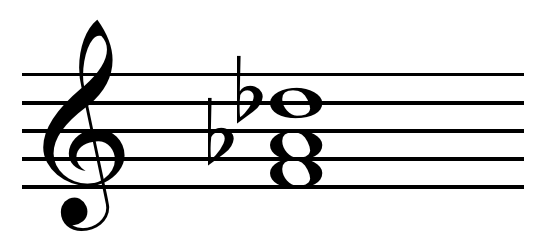supertonic on:
[Wikipedia]
[Google]
[Amazon]
In music, the supertonic is the second degree () of a  The supertonic chord normally functions as a predominant chord, a chord that resolves to a chord with dominant function. The supertonic chord lies a fifth above the V chord. Descending fifths are a strong basis for harmonic motion (see circle of fifths). The supertonic is one of the strongest predominants.
The supertonic chord normally functions as a predominant chord, a chord that resolves to a chord with dominant function. The supertonic chord lies a fifth above the V chord. Descending fifths are a strong basis for harmonic motion (see circle of fifths). The supertonic is one of the strongest predominants.

 In major or minor, the major chord built on the lowered supertonic () is called a Neapolitan chord (in C: D–F–A), notated as N6 or II6, usually used in first inversion. The supertonic may be raised as part of the common-tone diminished seventh chord, ii7 (in C: D–F–A–C). One variant of the supertonic seventh chord is the supertonic diminished seventh Kitson, C. H. (2006). ''Elementary Harmony'', p. 43. . with the raised supertonic, which equals the lowered third through
In major or minor, the major chord built on the lowered supertonic () is called a Neapolitan chord (in C: D–F–A), notated as N6 or II6, usually used in first inversion. The supertonic may be raised as part of the common-tone diminished seventh chord, ii7 (in C: D–F–A–C). One variant of the supertonic seventh chord is the supertonic diminished seventh Kitson, C. H. (2006). ''Elementary Harmony'', p. 43. . with the raised supertonic, which equals the lowered third through
diatonic scale
In music theory a diatonic scale is a heptatonic scale, heptatonic (seven-note) scale that includes five whole steps (whole tones) and two half steps (semitones) in each octave, in which the two half steps are separated from each other by eith ...
, one whole step above the tonic. In the movable do solfège system, the supertonic note is sung as ''re''.
The triad built on the supertonic note is called the supertonic chord. In Roman numeral analysis
In music theory, Roman numeral analysis is a type of Harmony, harmonic analysis in which chord (music), chords are represented by Roman numerals, which encode the chord's Degree (music), degree and Function_(music), harmonic function within a given ...
, the supertonic chord is typically symbolized by the Roman numeral "ii" in a major key, indicating that the chord is a minor chord
In music theory, a minor chord is a chord that has a root, a minor third, and a perfect fifth. When a chord comprises only these three notes, it is called a minor triad. For example, the minor triad built on A, called an A minor triad, has pit ...
(in C: D–F–A). In a minor key, it is indicated by "ii," indicating that the chord is a diminished chord (in C: D–F–A). Because it is a diminished chord, it usually appears in first inversion (iio6) so that no note dissonates with the bass note.
These chords may also appear as seventh chords: in major, as ii7 (in C: D–F–A–C), while in minor as ii7 (in C: D–F–A–C) or rarely ii7. They are the second-most common form of nondominant seventh chords.
 The supertonic chord normally functions as a predominant chord, a chord that resolves to a chord with dominant function. The supertonic chord lies a fifth above the V chord. Descending fifths are a strong basis for harmonic motion (see circle of fifths). The supertonic is one of the strongest predominants.
The supertonic chord normally functions as a predominant chord, a chord that resolves to a chord with dominant function. The supertonic chord lies a fifth above the V chord. Descending fifths are a strong basis for harmonic motion (see circle of fifths). The supertonic is one of the strongest predominants.

 In major or minor, the major chord built on the lowered supertonic () is called a Neapolitan chord (in C: D–F–A), notated as N6 or II6, usually used in first inversion. The supertonic may be raised as part of the common-tone diminished seventh chord, ii7 (in C: D–F–A–C). One variant of the supertonic seventh chord is the supertonic diminished seventh Kitson, C. H. (2006). ''Elementary Harmony'', p. 43. . with the raised supertonic, which equals the lowered third through
In major or minor, the major chord built on the lowered supertonic () is called a Neapolitan chord (in C: D–F–A), notated as N6 or II6, usually used in first inversion. The supertonic may be raised as part of the common-tone diminished seventh chord, ii7 (in C: D–F–A–C). One variant of the supertonic seventh chord is the supertonic diminished seventh Kitson, C. H. (2006). ''Elementary Harmony'', p. 43. . with the raised supertonic, which equals the lowered third through enharmonic equivalence
In music, two written notes have enharmonic equivalence if they produce the same pitch (music), pitch but are musical notation, notated differently. Similarly, written Interval (music), intervals, Chord (music), chords, or key signatures are con ...
(in C: D=E).
The term ''supertonic'' may also refer to a relationship of musical keys. For example, relative to the key of C major, the key of D major (or D minor) is the supertonic.
In Riemannian theory, the supertonic is considered the subdominant parallel: Sp/T in major though sP/T in minor (AM).
References
Diatonic functions 2 {{music theory stub